Traveling during the festival season is an ideal way to get an in-depth insight into the local culture. Long-established rituals show a lot about the spiritual side of human beings. Let’s discover what are 6 most important traditional festivals in Cambodia.
Still, if you want to rejoice over a specific festival or if you are curious about the real story behind the festival, it’s not that easy. With a more substantial proportion of Theravada Buddhists, many public holidays of the Cambodian have something to do with religious ritual. The festivals occur according to the Khmer calendar instead of the usual Georgian one, so you will find it challenging to remember when the most important festivals in Cambodia happen.
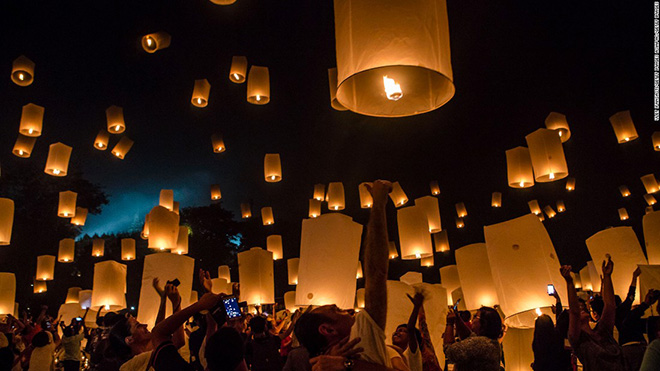
But don’t worry. We are here to help you. Following are Top 6 traditional festivals in Cambodia. If you are eager to learn about the cultural part of this country, choose one to join in.
1. Meak Bochea
As mentioned above, most festivals in Cambodia have something to do with their religion and the first festival of the year, Meak Bochea is the second largest in Buddhism.
Meak Bochea is also known as Māgha Pūjā or Macha Bucha Day. It is celebrated on the fifth of March in the lunar calendar and in most of the Buddhist nations, for example: Laos, Myanmar, Thailand, Sri Lanka.
According to the legend, on this day the Buddha and 1,250 of the first disciples had gathered and created an ideal and exemplary community.
The Cambodian celebrate Meak Bochea in a very traditional way. On the early morning, local people will give offerings, including foods and other necessities to the monks. This practice is nothing different from what they usually do on the other days.
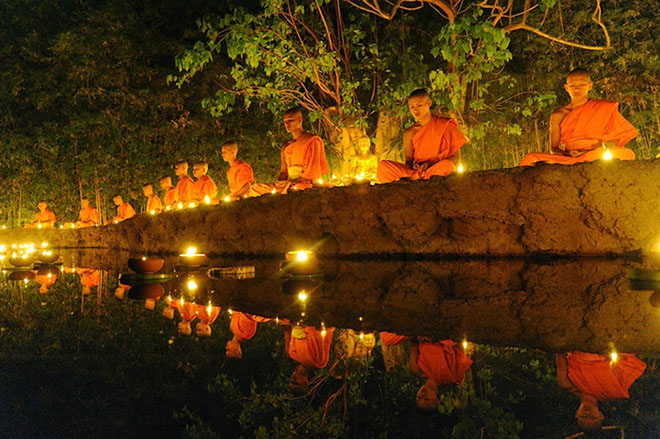
The Cambodian celebrate Meak Bochea in a very traditional way
However, the offerings on Meak Bochea tend to be more generous, but no money or precious things are given to the monks. Only foods and some necessary items such as clothes, towers.
After the sun sets, the native resident will flock to the nearby temple, listening to Buddhist preachings. Then they join a candlelit procession. People hold flowers, candle, and incense, walking around the temple for three times in a circle, which represent 3 Buddhist ideas: Buddha (the Holy God), Dharma (the community) and Sangha (the monks).
2. Choul Chnam Thmey or Khmer New Year
Choul Chnam Thmey, which can be literally translated into “Enter New Year,” is the time for the Cambodian to celebrates the Lunar New Year. Lunar New Year is a shared concept in many Asian nations like Vietnam, South Korea, China.
The thing is, Cambodian Lunar New Year doesn’t apply the lunar calendar to count the date. In fact, Choul Chnam Thmey is the only traditional festival in Cambodia to use Gregorian date and month. The holiday will last for three days with the first one falling either on April 13th or April 14th.
It coincides with the end of the harvest, and all people will return to their hometown for a family get-together. Peole clean up the house and prepare many traditional dishes. Native people also visit their ancestors’ shrines to light up candles and incense as an offering for the pass away.
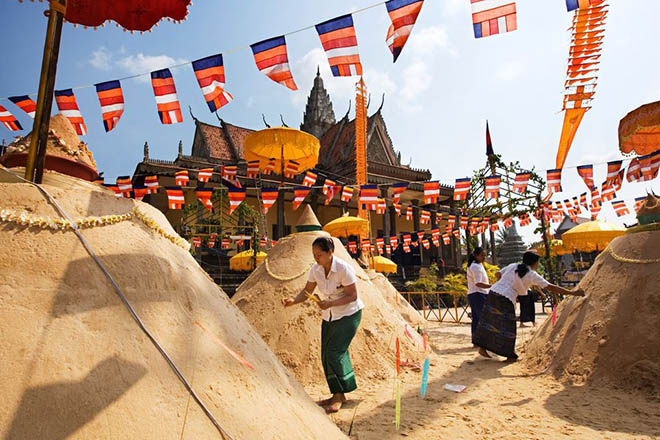
In the temples, the monks will carry some religious rituals to grant blessings for the ordinary people. On the last day of the Khmer New Year holiday, the Cambodian will splash water on each other as a gesture for blessings. It is similar to the Songkran in Thailand at a smaller scale.
3. Pithi Chrat Preah Neanng Korl or Royal Ploughing Ceremony
As an agriculture-based economy, rice growing is an essential aspect of Cambodia. Back to the XIII century, it was the same. Royal family members at that time had used a Hindu ritual in the ancient time to hold a ceremony to wish for a good harvest. It’s also believed to have fortune-telling ability, which allows people to forecast the weather and determine the best way to harvest.
The Royal Ploughing Ceremony occurs on the fourth day of the sixth month in the lunar calendar. It is organized outside the Royal Palace in the capital state of Phnom Penh. During the ceremony, the King or a picked representative will till a plot of land with a plow driven by two oxen.

People give many kinds of treats, including ice, corn, green beans, sesame seeds, freshly-cut grass, water, and rice whiskey to the animals after three rounds. The oxen’s choice of food will predict the condition of the upcoming harvesting season. Rice wine represents a crime. Water forecasts flooding. Grass suggests animal diseases.
4. Pchum Ben or Ancestors’ Day
While other festivals share some standard features with other traditions in other countries, Pchum Ben or Ancestors’ Day is a unique feature of Cambodia.
The word Pchum Ben means “to gather together a ball of food.” It’s the day for the Cambodian to show respect and gratefulness to the ancestors of seven generations. It happens on the 15th day of the 10th Khmer month, which is equal to October according to the Gregorian calendar. The exact date varies every year, so remember to double-check if you want to join in this mysterious festival.
Pchum Ben can be compared to Halloween in Western countries, but this former is more formal and serious. The Cambodian believe that the doorway to the hell will be opened on the first day of Pchum Ben, so the spirit of the deceased relatives can reenter the human world. That’s why they prepare a lot of offerings hoping their ancestor can find the merits. Many rituals aims to reduce the sins of the ancestors.

5. Bonn Om Touk or Water Festival
Despite the similar name with Songkran, Thailand Water Festival, Bonn Om Touk takes place on a completely different day and in a completely different way.
Cambodian Water Festival is usually in November when the water flow from Tonle Sap Lake, the largest freshwater in Southeast Asia begins to divert to the Mekong river. It marks the end of the rainy season, which brings about the prosperity to the biodiversity of Cambodia. The reversal of the flow from the Tonle Sap River to Mekong river is another aim of the festival.
During Bonn Om Touk, there is a wide range of festive activities in Phnom Penh. It is roughly estimated that upon a million Cambodians attend the celebrations in the capital city. Longboats are racing on the Mekong River. Parades with the water theme light up the streets. Fireworks displays make the nightlife more vibrant.
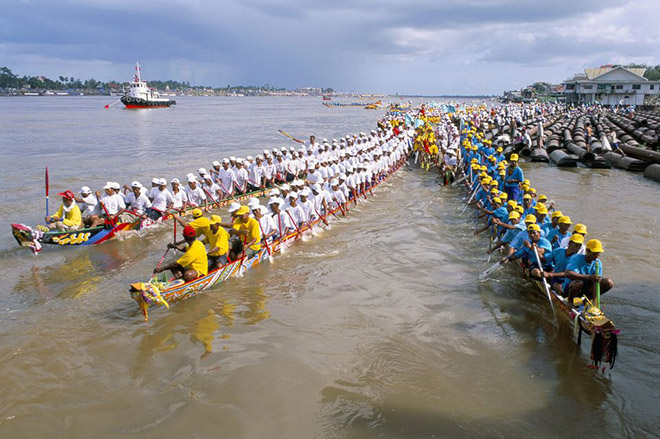
6. Vesak Bochea or Buddha’s Birthday
Vesak Bochea is an as important day as Meak Bochea to Buddhists. It is a three-in-one event in which there are three milestones of the Buddha’s life happened. Vesak Bochea is not only the date of birth but also the day Gautama Buddha, the ultimate God got enlightened, and even the time when he passed over to nirvana, the ultimate heaven.
Cambodian celebrate Vesak Bochea on the full moon night of the sixth lunar month, about ten days after the Royal Ploughing Day.
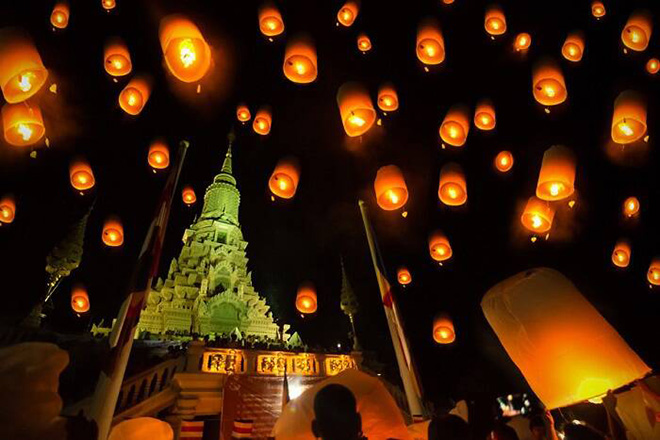
To pay homage to the Buddha, the Cambodians will donate foods and clothes to the monks. Some people also go on a fastening day or week to display respect. Temples and pagodas in Cambodia welcome a huge number of visitors from all over the countries on this occassion.





Comments